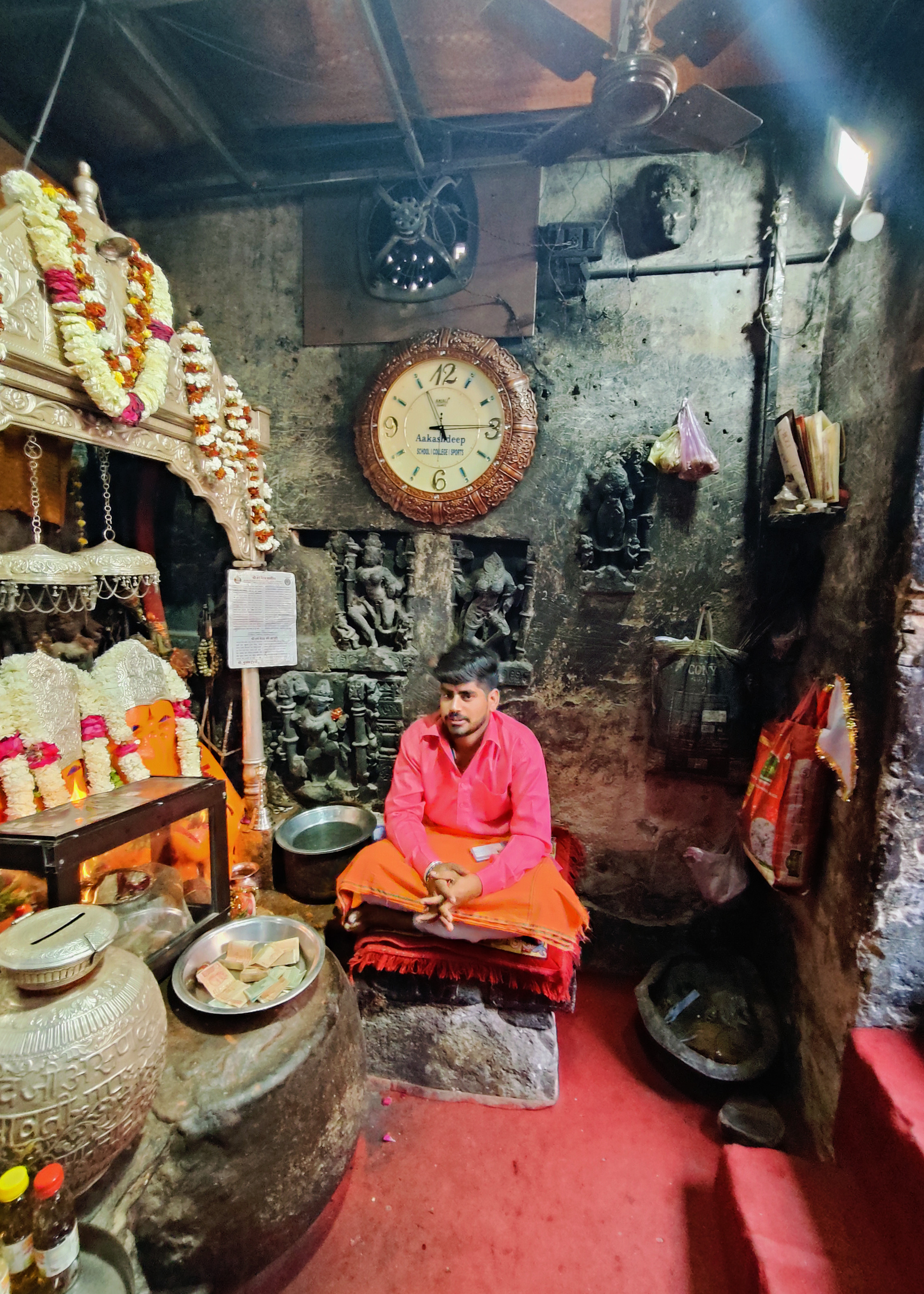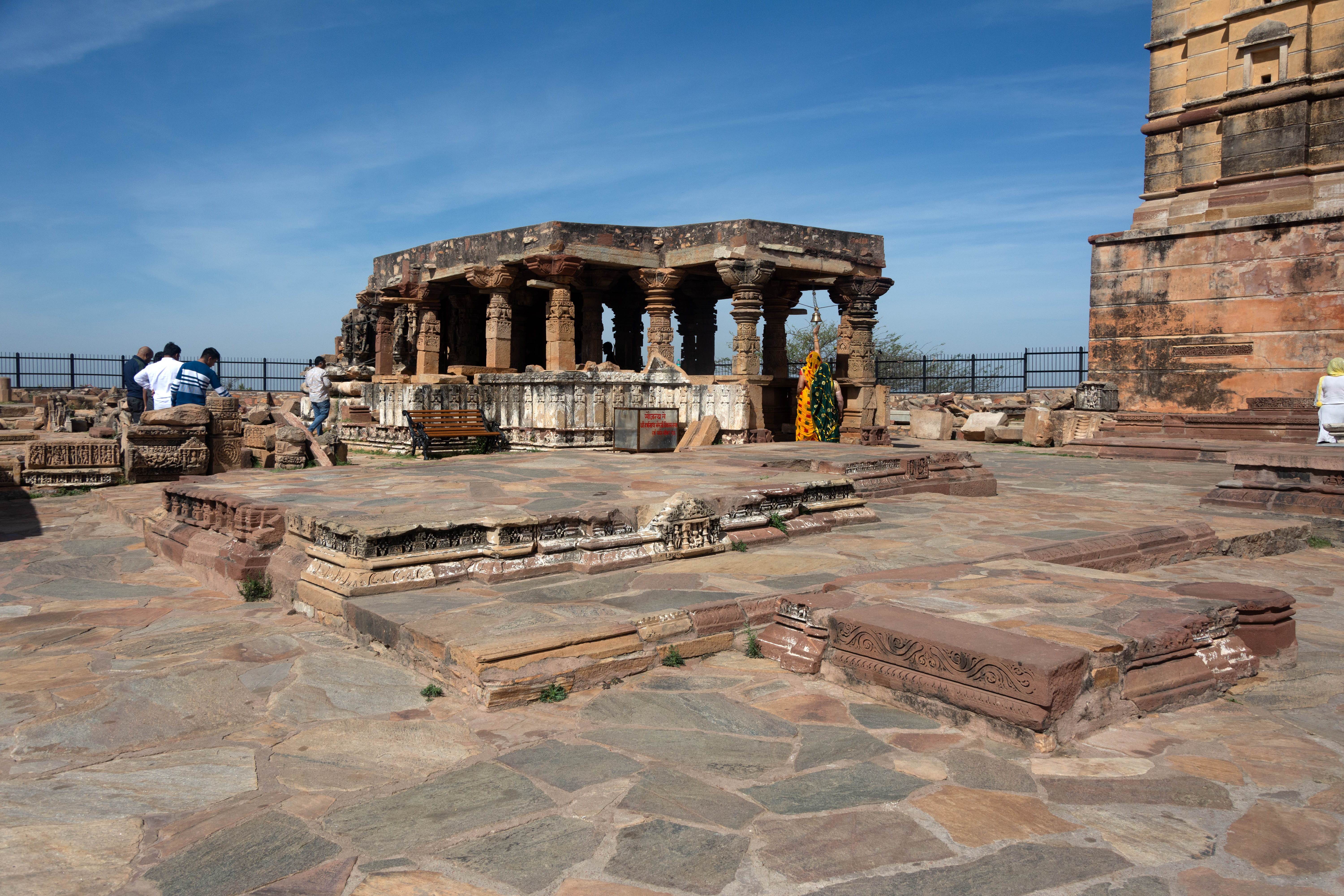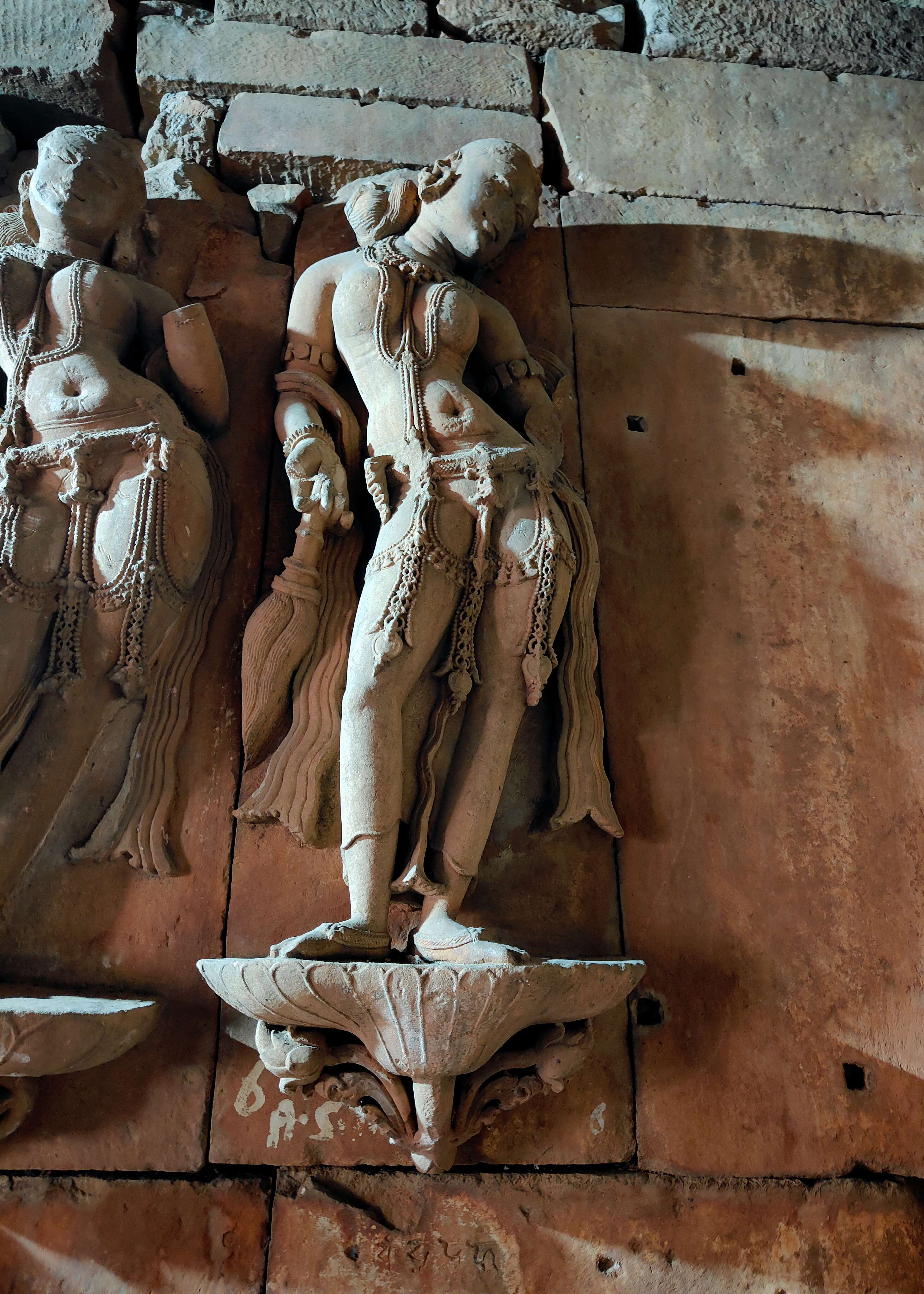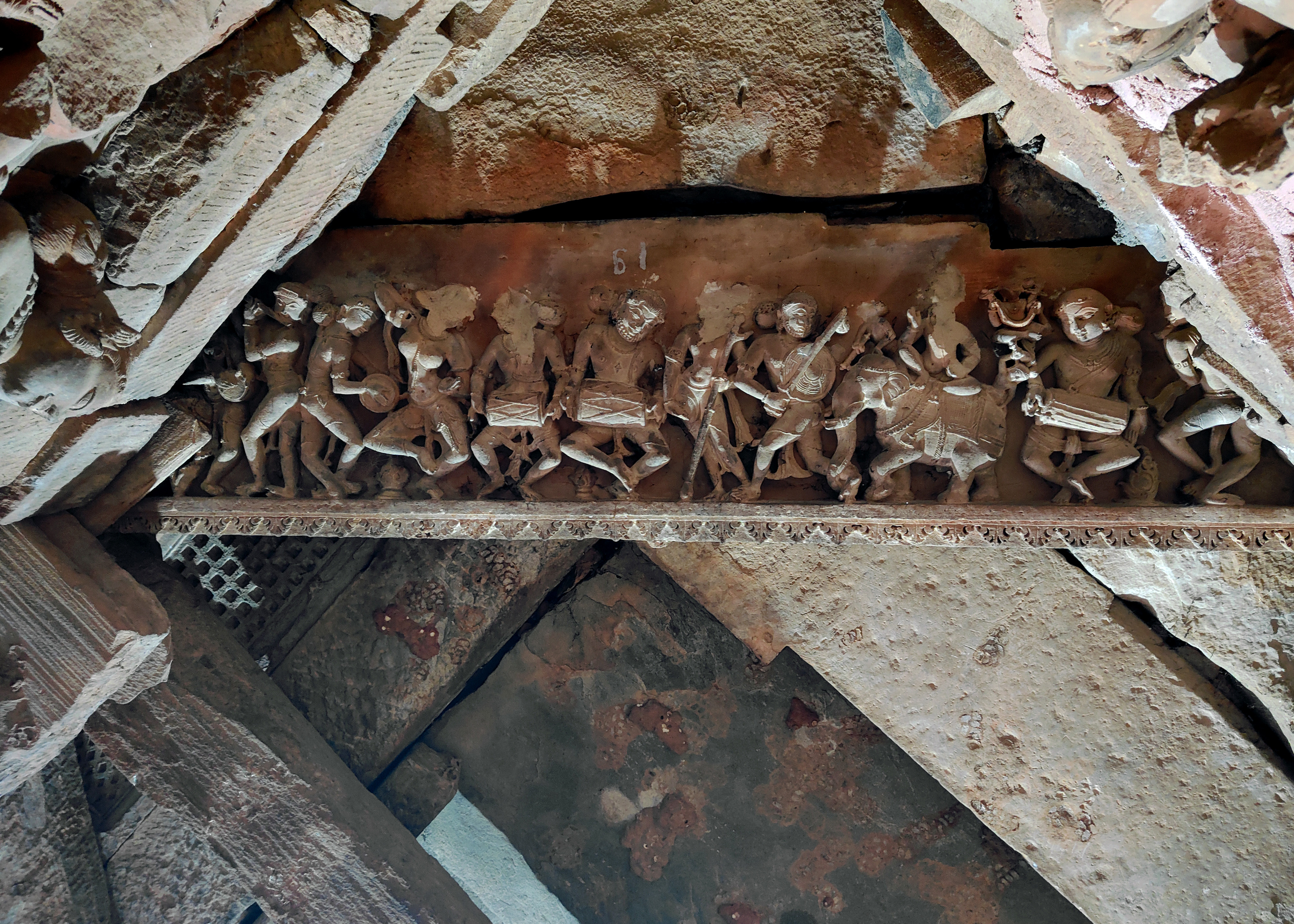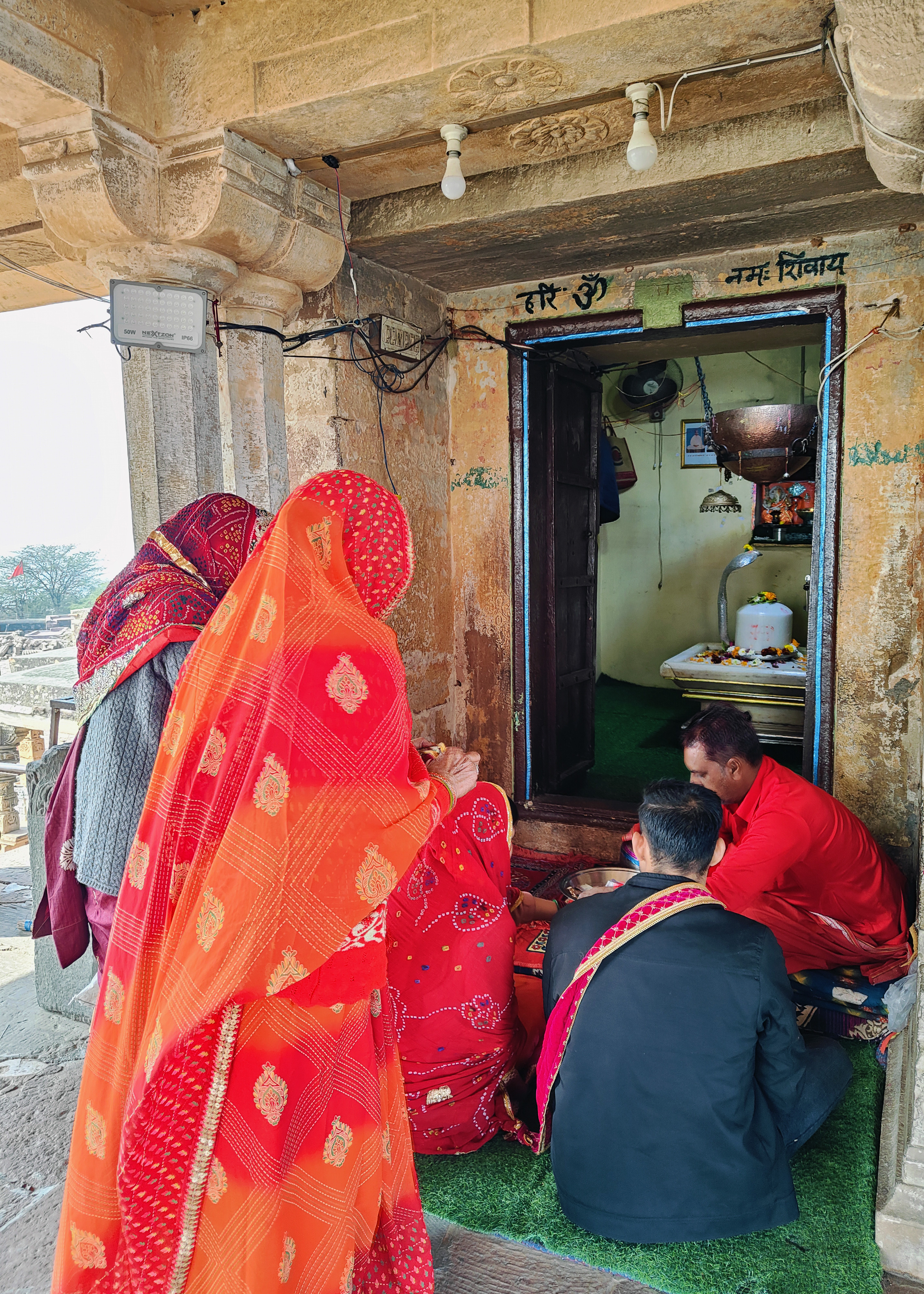The Harshnath Temple: Divine abode of Shambhu on Harsha Hill
By Anchit Jain
There was once a wise man named Harsha, who lived in a village in the Churu district of Rajasthan with his beloved sister, Jina. The two became orphaned at a very young age, but their deep love was sufficient to support each other. He was soon married to a lady, jealous enough not to tolerate the excessive love of the siblings. The two ladies entered into a dispute about which of the two is loved more by Harsha. To determine it, both carried water-filled earthen pots on their heads and called for Harsha’s help. Unlike usual days, that day Harsha, unaware of the bet, first took off the pot from the head of his wife! Furious Jina permanently left her village to stay at the Kali-Shikhara hill in Sikar, Rajasthan, and started worshipping the Goddess Durga. Disheartened, Harsha tried his best to persuade his adamant sister but, on his failure, decided to permanently settle at the nearby hill, later named after him as Harsha-giri. There was one self-manifested or svayambhu shivalinga at the hill called the Pancha-mukhi Mahadeva. He worshipped the deity with utmost devotion, and Lord Shiva blessed him to worship the deity in Kaliyuga as the Harsha Baba or the Harsha Bhairon. [1]
Every year thousands of pilgrims travel to Harsha Hill, located 22 km from Sikar in Rajasthan, to receive darshana (pay homage) and perform ceremonies at the shrine of Harsha Bhairon, or Harsha Baba, believed to be the kula devata (family deity) of many local castes and the patron deity of the city of Sikar. The Jina-mata mandir, located on a nearby hill, is another major religious center in the city, dedicated to the local form of the goddess. Folk legends, at some point in their history, integrated the shrines dedicated to two local deities. Harsha Bhairon is worshipped on Harsha Hill as a semi-iconic rock smeared in orange paint, a common visual depiction of Bhairon throughout the subcontinent, but here with three abstract heads (Image 1). The idol is placed in a small room in the underground storey, which is part of a walled enclosure on the hill that was likely built in the late medieval period. The walls and other portions of this complex affix several sculptures, roughly dating to the second half of the 10th century CE. These sculptures, which once adorned at least a dozen temples from the 10th–11th centuries that once dotted the hill, now only remain in the form of base courses. The only surviving temple from that period, albeit in a dilapidated and ruinous state, is the historical Harshnath Temple dedicated to Shiva, which was built in the second half of the 10th century CE (Image 2). It was this temple and its presiding deity, as we learn from the local epigraphs, that led to the hill being referred to as the Harsha Hill and not the Harsha Bhairon of folk legends. The historical Harshnath Temple is still in active worship, with an ancient four-faced linga (an aniconic representation of the Hindu god Shiva) inside the sanctum known as Pancha-mukhi Mahadeva. The four faces on the sides, as well as the space at the top representing the fifth face (sometimes visually depicted), represent Shiva in his Sadashiva aspect.
The folk hero Harsha once worshipped this linga, which locals believe to be a svayambhu, or self-manifested one. Later, the Chauhan rulers of the Shakambhari lineage built a structural temple around it. It is difficult to trace the origins of Shaiva associations with the hill. Artistically, the linga is almost contemporaneous with the main shrine. However, some scholars have raised reservations about its status as the original cultic image of the shrine, suggesting it might have been a later replacement. [2] Archaeologically, the earliest certain evidence of the religious association of this hill is not with Shiva but with Surya, the Sun God. Ambika Dhaka dated an independent sculpture of Surya, now located in a masonry shelter near the Harsha Bhairon Temple on the hill, to the 8th century CE. [3] The findings of independent Surya sculptures suggest a continuation of the Surya association at the hill, leading to the construction of more shrines dedicated to Surya in the 10th–11th centuries. The hill also saw the construction of temples dedicated to various other Brahmanical deities. A large number of independent yogini (manifestation of the mother goddess) sculptures led to the speculation of a lost yogini temple compound, the Chaunsath Yogini compound, featuring a standard sixty-four or varying numbers of female deities. During this period, Vaishnavism also gained significant prominence on the hill. Elizabeth Cecil identified three displaced temple lintels within courtyards at the site, where Vishnu appears to be the central deity, indicating the presence of at least three Vaishnav temples at the hill. [4] Several independent Vaishnava images support the maturity of the Vaishnava tradition. Particularly noteworthy is an image of Vaikuntha Vishnu (a four-faced image with the heads of a lion (right) and a boar (left) flanking a human head), which reveals the presence of the Pancharatra [5] form of Vaishnavism at Harsha Hill.
In the second half of the 10th century and early 11th century, the hill was home to at least a dozen shrines dedicated to various deities. [6] However, the complex was not designed or planned to be a panchayatana (a layout of a main shrine with four subsidiary shrines at four corners), as the number and distribution of the sub-shrines do not follow the order of symmetry and proportions.[7] The historical Harshnath Temple served as the foundation for most of these shrines, underscoring the temple's spatial and religious significance. Surprisingly, the extensive Harshnath Temple inscription of VS 1030 (973 CE) did not record any of these diverse sectarian shrines, with the exception of the Harsha temple. The Government Museum, Sikar currently houses this inscription, which is considered the most important document of early Chauhan history, engraved on a large slab of black stone. The inscription reveres Shiva as Harsha-Shambhu and recognises him as the Chauhan dynasty's kuladevata.
The inscription records the achievements of various rulers from this lineage, beginning with Guvaka I, who likely ruled in the first quarter of the 9th century CE and served as a vassal of the powerful imperial Pratihara dynasty during the reign of Nagabhata II of Kannauj. He was possibly the first ruler of this lineage to establish royal ties with Lord Harsha. The inscription does not clarify whether the shrine was commissioned by Guvaka or if it predated his time and was revered deeply by him. However, what becomes apparent by this time is the Shaiva association with the hill and that the dominance of Shaivism at the site had surpassed all other traditions, including the earlier presence of the Surya tradition dating back to the 8th century. In the second half of the 10th century CE, the Shaiva shrine of Harshnath likely replaced an older, humble shrine from Guvaka's time. This reconstruction likely occurred during the time of King Simharaja, who is praised in the inscription for his generous land grants to the Harsha Temple, renovation of the temple, establishment of an andaka (gold shell) on the temple spire, and granting various villages to the Harsha Temple (v. 18). So far, the Chauhans house was simply a minor feudatory of the imperial Pratihara dynasty. However, the fortunes of the dynasty changed under the subsequent ruler, Simharaja, who became the first Chauhan ruler of Shakambhari to assume the title of maharajadhiraja (the King of Kings) by freeing his territory from the suzerainty of the Pratiharas. [8] Although Simharaja provided generous charities to the temple, the process of temple reconstruction did not happen under the leadership of any temporal ruler but under the spiritual leadership of ascetics from the powerful Pashupata tradition. Verses 33-34 of the Harsha stone inscription celebrate ascetic Allata, who used funds from devout individuals to build the temple of Harshnath. His faithful pupil, Bhavadyota, completed the remaining task after his death. The temple also received generous financial support from Vigraharaja, Simharaja’s son, as well as several traders, merchants, and individuals from nearby villages.
Architectural Features
Several art historians have commented on the archaeological remains of the Harshnath temple complex. D.R. Bhandarkar made one of the earliest observations in 1913, attempting to establish correlations between the epigraphical descriptions and the archaeological remains of the site. The complex is described as follows in verse 12 of the Harshnath stone inscription:
‘Glorious is the mansion of the divine Harshadeva, which is charming with the expanse of (its) spacious hall (mandapa), exquisite with the splendour of a gold shell, (and) lovely in consequence of (the statues of) Vikata and the sons of Pandu set up in the row of structures along (its) sides. Resembling (in height) the peak of Meru, it is pleasant on account of an excellent arched doorway (torana-dvara) and well-carved bull (Nandi) and is full of manifold objects of enjoyment.’ [9]
Bhandarkar connects the epigraphical description of the temple complex with the archaeological remains, stating that one can trace all the parts of the temple mentioned in this verse among its ruins on the hill. A long flight of stairs leads to the temple's courtyard. Just where these stairs end are the shafts of two pairs of columns, one in front of the other, which were no doubt once surmounted by a torana and formed the arched entrance, as stated in the verse. A little further on, on a raised terrace, is an old marble image of Nandi, once no doubt placed in a pavilion, of which only the plinth has survived. This is unquestionably the bull mentioned in the inscription. It also says that there were other structures on the sides of the temple, and that one of them contained the images of the Pandavas and Vikata. The remains of the subsidiary shrines on the south and north-west clearly prove the existence of these structures. The ruins on the north-east also clearly display the images of the Pandavas. Here are six colossal images, which were originally as high as seven feet when they were whole and complete, and which people still believe to be those of the Pandava brothers and Draupadi. [10] However, Bhandarkar's identification of Vikata as the ogress Hidimba, as the term refers to Parvati, is problematic. [11]
The Meru-like shrine of Harshnath, as described by the inscription, is now in a significantly ruinous condition. A rangamandapa, a pavilion with an interior platform for religious ceremonies, joins the east-facing temple's mulaprasada (main shrine), which is of tri-anga (three planes of an offset) specification. It lacks the pitha (lowermost plinth of the temple), but it begins with a single plinth course. While some parts of the vedibandha (basal mouldings) are damaged, the kumbha (pitcher) features an intricate udgama (pediment) motif, accompanied by a small central box that holds a figure. The nearly completely destroyed jangha (main wall) featured dikpalas (gods of the cardinal directions) at the karnas (corner projections), as evidenced by the remains discovered in the north-eastern corner, which bear an image of the dikpala, Isa. The surasundaris or apsaras (celestial damsels) were possibly found at the pratirathas (intermediate main projections) as well as in the salilantara-recess. Vyalas (mythical composite creatures) were also present, possibly in the recesses flanking the bhadra (central projection on the temple's walls) niches. The nature of deities in the bhadra niches cannot be ascertained but can be conjectured to have Shaiva associations. The collapse of the superstructure suggests that it may have been of the anekandaka shikhara (multi-spired superstructure) variety. While this shrine exhibits features of the Maha-Maru style, some later shrines in the complex, with only bases surviving, suggest an influence of Maha-Gurjara features in the mouldings of the jagati (platform). [12]
The antarala (vestibule) of the temple stands in a renovated form, and the pillars of the vestibule seem to be a later replacement. [13] The mandapa (pillared hall) consists of a rangabhumi, which is a raised platform with four pillars on its four corners and transepts. All of the rangabhumi's pillars are different in measurement and ornamentation, with no uniform thickness. Ambika Dhaka suggests these pillars are from another temple. She has identified two pillar fragments in the Government Museum, Sikar, which she argues are likely to be a part of the original temple. [14] One of the pillars is quite different from the others, as it features an image of Goddess Parvati and apsaras on all sides of the niches. Below them are images of Shaiva ascetics worshipping the shivalinga and playing musical instruments, apsaras, dancers, and musicians. If these pillars are indeed not original, it indicates that there is at least one more Shiva temple at the site. The archaeological remains of Harsha Hill and the museums house several Shaiva images, all but one of which are part of architectural fragments or the devakostha (niches) of the temple walls.
The doorway of the garbhagriha (sanctum sanctorum) has the lalatabimba (lintel) exhibiting the gods Brahma, Vishnu, and Shiva. Given the temple's dedication to the Lakulisa Pashupata belief system, we can assume that this lintel is not the original one. The doorframe is saptashakha (has seven bands), and the dvarapalas (door guardians) and river goddesses Ganga and Yamuna occupy their standard positions. Inside the sanctum is a four-faced linga, still worshipped as Pancha-mukhi Mahadeva, representing Shiva in his Sadashiva aspect. As previously noted, this idol, though contemporary to the main shrine, may not be the original cultic image. The sanctum's principal wall represents Shakti as Parvati in panchagni-tapa (penance), with beautiful sculptures of nayikas (female dancers) encircling the wall (Image 3). They stand in swaying movements and turn toward the central figure, Parvati. Interestingly, the 10th-century Kutila script inscribes their names there (Image 4).
People refer to Parvati as Godhasana Gauri [15] or Godhikasana Gauri because she stands upright on an iguana. [16] Flaking her are two standing and two sitting female attendants. An unusual epithet for Goddess Vikata once appeared below the seated female attendant to the left of the sculpture. R.C. Agrawal first reported and discussed this epithet in 1967 [17], but mischievous individuals later erased it. Under the image of Parvati are a few letters, PA. PU. DA., which are likely marks of a mason. [18]
Interestingly, the unusual epithet, Vikata, also appears in the Harsha stone inscription, which Bhandarkar had problematically identified as the ogress Hidimba. However, Agrawal’s pertinent discussion on the epithet inscribed below the image of Parvati in the sanctum clarifies that the goddess was locally hailed as Vikata at Harsha Hill. Agrawal gives a possible explanation for this unusual name: ‘Gauri was treading the Vikata Marga by performing penance, and it appears that she was so named as Vikata; the word is derived from the Sanskrit word Vikata.’ He further adds that the Avanti Khanda of the Skanda Purana alludes to Vikata as a goddess, mother, and yogini, and that the eulogists of the Harshnath inscriptions may have drawn inspiration from this text. [19]
The sanctum's ceiling features exquisitely carved friezes. One frieze depicts Indra seated on his elephant, Airavata, surrounded by numerous drumming and dancing gods. At the centre of the frame is a dancing figure, identified by Stella Kramrisch as Indra himself, who became one of the dancers. 20 The depiction recalls verse 7 of the Harshnath stone inscription, which records Indra’s devotion towards Shiva.
He [Shiva]—who, full of joy (Harsha) after he incinerated the enemies of the gods at Tripura with his burning arrow (and) was worshipped by a multitude of joyful gods led by Indra, who praised and bowed to him—took up residence here on the mountain peak under the very name Harsha out of favor for Bharata [India]. May that moon-crested one, now with a second residence, dwell (here) in the form of the linga for your well-being. (v 7)
Harshnath Temple and its Afterlife
The humble shrine dedicated to Lord Harsha, the place where Guvaka fostered his royal relations with the lord, soon emerged as a royal belief centre. The Chauhan rulers, traders, and rich individuals financially patronized the shrine, even though Shaiva ascetics of the Pashupata tradition led its re-erection in the second half of the 10th century. The Harshnath stone inscription records donations from ruler Vigraharaja II, under whose reign the inscription was composed, as well as donations received from his predecessors. However, there is little doubt that his patronage continued. Ambika Dhaka discovered two small epigraphs inside the sanctum inscribed above two damsels, referring to a certain Chamunda Raya or Raja. [21] He appears to be a later successor to the dynastic line who lived in the 11th century, hinting towards a sustained patronage at least until this time.
The temple is now in a ruinous condition. K. Deva, M. W. Meister, and M. A. Dhaky argue that "the temple collapsed within centuries after its erection, either due to an insufficiently deep foundation or by some calamity such as an earthquake." The destruction of the temple may not have been caused by Islamic iconoclasts. In an interesting anecdote, locals allegedly held Mughal ruler Aurangzeb responsible for the sad fate of the historic temple, following a pan-Indian convention.
The local tradition goes that there were some eighty-four temples at Harsha Hill but were ravaged by Aurangzeb, who was curious about the light of a flickering lamp burning inside the Harsha Temple, which he could directly see on a clear day from his capital in Delhi! He then embarked on a quest to destroy the Jinamata Temple. However, a swarm of bees attacked him. Aurangzeb apologised to the goddess and promised to patronise Lord Harsha Bhairon, whose shrine he had forgotten to ravage. [22]
The exact timing and circumstances of the decline of the Harshnath Temple and its surrounding temples cannot be determined. Signs of repairs and replacements, such as the lintel of the door, pillars, and the linga inside the sanctum, suggest ongoing maintenance, but it is difficult to ascertain when these took place. According to local traditions, Harsha Bhairon's shrine predates the Kaliyuga. The origins of this cult and the shift in Harsha's identity from the shivalinga of Harshnath to Bhairon are obscure. Shaiva association with the hill continued in mediaeval centuries, either in relation to the Harshnath Temple or the shrine of Harsha Bhairon, or both. This association prompted the first chieftain of Sikar, Ras Sahoo Singh, to build a new Shiva Temple on the hill in 1718 CE (Images 6 and 7), adjacent to the Harshnath Temple. Some early modern structures also exist near the Bhairon shrine. At some point, several 10th-century sculptures were affixed to the walls of these structures as well as the enclosure of Harshnath Temple. For several generations, Parasher Brahmins from Harsha village have performed priestly services in these temples.
Festival and Cultural Traditions at the Harsha Hill
Today, Baba Harshnath, or Harsha Bhairon, occupies the central spiritual space on Harsha Hill, drawing numerous devotees and serving as the kula devata of many local families. Newlywed couples, who are expected to start their marital journey with his blessings, first offer their prayers to the mediaeval Shiva Temple, where the pujari performs various rituals and ceremonies. After visiting the historic but dilapidated Harshnath Temple to venerate the Pancha-mukhi shivalinga, they conclude their visit at the shrine of Harsha Bhairon, where the principal ceremonies take place. Jharula, or mundana (hair tonsuring), is also a common practice at the shrine.
In addition to Shivaratri, Harsha Hill celebrates Bhadra-krishna-trayodashi, the thirteenth day of the waxing moon in the month of Bhadrapada (August-September), with great fervor and elaborate decorations. The hill hosts an annual fair, known as baba ka mela, for 10-15 days, three times a year during the month of Bhadra and during two navaratris. To mark the new year, the hill hosts a grand bhandara (food distribution), inviting the entire city of Sikar and nearby villages to participate in baba ka prashada, a nine-day festival dedicated to the mother goddess, or Goddess Durga. The hill hosts a grand bhandara (food distribution) to mark the new year, inviting the entire city of Sikar and nearby villages to participate in baba ka prashada. For tourists, the ideal time to visit the hill is during the monsoon season, when the lush greenery blankets the area, creating a hazy ambience described by locals as reminiscent of Manali.
Footnotes:
[1] This folk legend, well known to locals, was narrated by the chief priest of Bhairon Temple on February 14, 2024.
[2] Dhaka (377) highlights a strong possibility of it being a later replacement based on two points.
1) This four-faced linga has three benevolent faces and one fierce. As per the texts, the fierce side should be facing southward but here it is in the north.
2) There is a difference in the circumference of the Linga in situ which is smaller and the socket which is bigger.
[3] Dhaka, ‘A fresh light on architectural and sculptural art of Shiva temple at Mount Harsha,’ 379
[4] Cecil, ‘The Medieval Temple as Material Archive.’
[5] Pancharatra Vaishnavism is an ancient sect centered on the worship of Lord Vishnu/Narayana as the supreme entity and elucidates different aspects and manifestations of the divine, through the concept of vyuha or emanations and avatar or manifestations. Its rituals and devotional practices are outlined in a large corpus of Pancharatra texts.
[6] Cecil, ‘The Medieval Temple as Material Archive.’
[7] Dhaky, Meister, and Deva, eds., 107.
[8] Jain, Ancient Cities and Towns of Rajasthan, 396.
[9] Bhandarkar, ‘Some unpublished inscriptions reconsidered,’ 57–58.
[10] Ibid.
[11] Agrawal, Bhāratiya Vidyā, vol. 27, and Agrawal, Goddess Vikatā of Harshanātha.
[12] Dhaky, Meister, and Deva, eds., 107.
[13] Dhaka (377) has suggested that only the base or kumbha part of these pillars is original and the remaining is a later addition.
[14] Dhaka, ‘A fresh light on architectural and sculptural art of Shiva temple at Mount Harsha,’ 377.
[15] Agrawal, ‘Goddess Vikatā of Harshanātha,’ 246.
[16] Dhaka, ‘A fresh light on architectural and sculptural art of Shiva temple at Mount Harsha,’ 375.
[17] Agrawal, Bhāratiya Vidyā, vol. 27, 58.
[18] Dhaka, ‘A fresh light on architectural and sculptural art of Shiva temple at Mount Harsha,’ 376.
[19] Agrawal, ‘Goddess Vikatā of Harshanātha,’ 246.
[20] Kramrisch, The Hindu Temple, 402–403.
[21] The epigraph Dvar li dvar srita chamunda rajasyaha was inscribed above the head of the first damsel in the eastern wall and holding fire flames in her right hand, and again on damsel number thirteen (excluding Gauri), fixed in the northern wall, but with slight variation. Dhaka (2001:376)
[22] Anecdote narrated by the chief priest of Bhairon Temple on February 14, 2024.
Bibliography
Agrawal, R.C. Bhāratiya Vidyā. Bombay. Vol. 27. 1968.
Agrawal, R.C. ‘Goddess Vikatā of Harshanātha, Sikar.’ In Jignasa: Journal of History of ideas and culture Part-2, edited by Vibha Upadhyaya, Jaipur: University of Rajasthan, 2011-2012.
Barrows, Herbert. Reading the Short Story. Vol. 1 of An Introduction to Literature, edited by Gordon N. Ray. Boston: Houghton Mifflin, 1959.
Bhandarkar, D.R. ‘Some unpublished inscriptions reconsidered-Harsha stone inscription of Vigraharaja.’ Indian Antiquary, no. 42 (1913): 57-64.
Cecil, Elizabeth A. ‘The Medieval Temple as Material Archive: Historical Preservation and the Production of Knowledge at Mount Harsha.’ Archive Journal. 2017. https://www.archivejournal.net/essays/the-medieval-temple-as-material-archive/.
Dhaka, Ambika. ‘A fresh light on architectural and sculptural art of Shiva temple at Mount Harsha, Sikar.’ In Purā-Jagat-J.P. Joshi Commemoration Volume. Edited by C. Mangarbandhu, A. K. Sharma, B. R. Mani, G.S. Khwaja, 370-380. Delhi, 2001.
Dhaky, M. A., Michael Meister, and Krishna Deva, eds. Encyclopedia of Indian temple Architecture North India: Period of Early Maturity c. AD 700-900. Princeton, NJ: Princeton University Press, 1991.
Jain, K. C. Ancient Cities and Towns of Rajasthan: A Study of Culture and Civilization. Delhi: Motilal Banarsidass, 1972.
Kramrisch, Stella. The Hindu Temple, Volume 2. Delhi: Motilal Banarsidass, 1946.
Sharma, Dasharatha. Early Chauhān Dynasties: A Study of Chauhān Political History Chauhān Political Institution and Life in the Chauhān Dominions from 800 to 1316 AD. Jodhpur: Books Treasure, 1959.
